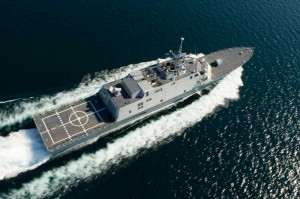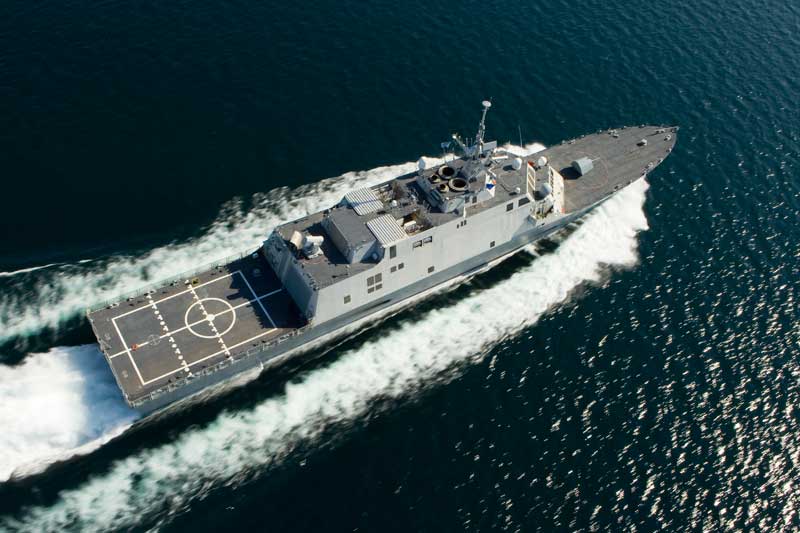
Littoral operations for US and allied navies have largely focused on warfighting as the defining element. For a “blue water” fleet like the US Navy, the littorals are the areas passed through in shaping the battle on the air and land in confronting adversaries. The goal is to destroy enemy assets and to shape a decisive military outcome in the adversaries area of strategic control or interest.
For allied navies, littoral operations have not had the same meaning, in terms of linking those operations to deeper strike floating blue water assets. But they too have been defined by the military capabilities of the littoral fleet to defeat enemy assets operating close to their territory and to be able to defeat land-based air-breathing assets launched from their territory, which could deny allied forces ability to operate in the littorals.
No one would deny the centrality of these missions or capabilities. If either a blue-water force or a littoral force is unable to manage threats to their ability to operate, they clearly will be unable to provide credible capabilities to operate against adversaries or enemies in the littorals.
But, increasingly, the nature of 21st century operations operates in more ambiguous situations. Indeed, one could argue that decision-makers send naval forces into the littorals to control an area of tactical or strategic space, more to influence events within that space than to seek to generate military action against land forces or to start a war.
The insertion of force is generally initiated to deal with security threats and challenges within an area of tactical or strategic interest. The initial operation is generated by the need to provide for security in an unstable area, or to influence events, which could get out of hand. The initial force may be limited in character and circumscribed by very specific rules of engagement.
The task then for the littoral force is to operate in an area of variable size in the littorals for a variable period of time, but capable of enduring within the littoral space to shape events and to manage crises.
To do so, the maritime littoral forces carry with them capabilities to link to C4ISR assets, either solely organic or characterized by significant reachback to national or allied forces. Enduring littoral presence requires a significant capability for scalability. The initial littoral insertion force needs enough autonomy in terms of sustainment, defense, and C4ISR to be able to operate effectively. But if the evolution of the situation demands its over time-enhanced capabilities can be provided to the littoral force by reaching back to sea-based or land-based national or allied assets.
Certainly counter-piracy and sea-lanes of communication missions are core examples of the enduring littoral presence mission. In the wake of World War II and the Cold War, the USN has defined sea lines of communications or SLOC missions as largely blue-water missions requiring an ability to defeat blue water navies and related assets denying the ability of the US, and allied and partners to operate freely at sea.
But the reality is that in a world of significant commercial shipping, almost all of it not under US control, SLOC control begins with an ability to work with the commercial sector. It continues with an ability to work with local coast guards and law enforcement agencies. And this requires a C4ISR capability to work between military vessels and commercial and law enforcement agencies of foreign partners.
As the enduring littoral maritime presence mission becomes more effectively prioritized, naval capabilities will be re-crafted.
To take the American example, among the key elements, which the US will need to bring more effectively into, play is the following:
- The initial insertion force might well be a US Coast Guard force using the new National Security Cutter or LCSs acquired as the so-called OPC (offshore patrol cutter). These assets will have organic ISR attached to their operations and be hopefully optimized by a C4ISR system which can work with the commercial and law enforcement sectors.
- New USN LCS vassals able to work in joint operations with the USCG could join these assets. Or, alternatively, the USN will deploy LCS or destroyers initially and again, will need to have organic assets for C4ISR able to deal with the appropriate security threat, namely an ability to work with commercial and law enforcement sectors in shaping a response.
- Whether USCG or USN assets, there is a need to link up to air-breathing and space-based assets and to reachback to land or sea-based military assets. This will be crucial to shape scalability options and hence shape a crisis management “escalation” ladder.
- To work effectively, the ships, including LCS will need to link with USAF and USN and USMC aviation assets. As the F-35 and Ospreys are introduced in numbers, an ability to integrate with their C4ISR capabilities will be important in shaping enduring maritime presence capabilities.
- It is in this sense that the significant role of USMC amphibious ships should be understood. Far from being relevant only when the US has a forced entry option, small “floating” force augmentation assets at sea could provide significant reachback and scalability contributions to a littoral force.
- If such deployed assets do not suffice to deal with the problem, further reacback to significant USAF or USN assets would be called for. The point is that in the evolution of the most likely 21st century missions, the insertion force will be small and its mission circumscribed. The management capability which one wants to have in shaping crisis management in the littorals is reachback, connectivity, and scalability. But this is exactly the opposite of how the USN is currently postured.
Nonetheless, changes are underway which could shape such an approach.
First, the USN has signed agreements with the USMC and the US Coast Guard to have a joint operational concept.
Second, the decline of the numbers of USN assets has led the navy leadership to prioritize a new maritime strategy, which features working with other navies. Associated with the new strategy is a priority on the operation of global fleet stations at which the USN creates at sea bases able to work in deployed areas of need and opportunity.
Third, the USN and perhaps USCG will procure the LCS, which calls out for an effective operating concept.
Fourth, the USMC and USN are introducing the F-35, which is a “flying combat system” whose ability to link to other assets as a force multiplier makes it a natural candidate to work with the LCS or other littoral assets.
Fifth, the F-35 will be a global coalition asset, which allows for sharing of effective approaches generated for US forces to work with allies in joint con-ops for enduring littoral presence missions.
Sixth, the USMC is introducing the Osprey onto its ships and as such the Osprey with its speed and range could contribute force-multiplying capabilities to the initial forces inserted into littoral operations.
Seventh, the QDR review provides an opportunity to focus on the USMC amphibious ships in ways beyond repeating Inchon.
Eighth, the UAV revolution provides a significant opportunity to shape options for initial littoral forces to carry organic ISR, and provides opportunities to use longer-range UAV support, such as the N-UCAS in support of littoral missions.
Ninth, the connectivity opportunities inherent in moving beyond proprietary solutions for communication open up a significant opportunity to move the militaries into the world of connectivity to commercial and law enforcement communities operating in the littorals.
And finally, the need to re-shape military space provides opportunities as well to use commercial assets more effectively in operating with the commercial, allied, and law enforcement communities.
In short, the shift from littoral warfare to enduring littoral maritime presence can see a significant change in how maritime forces integrate with air-breathing and C4ISR asset; and in ways military forces work with the commercial, coast guard and law enforcement sectors.
———-
***Posted September 7th, 2009


